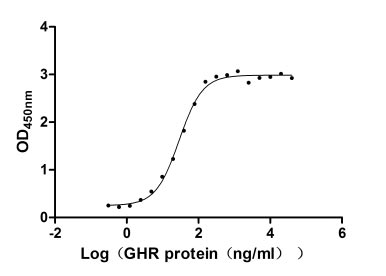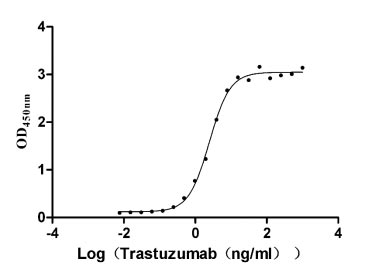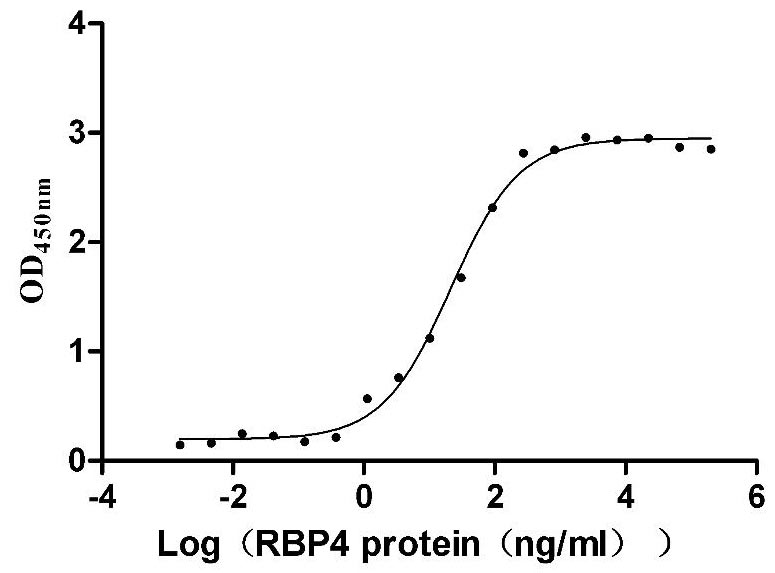Recombinant Human Homeobox protein SIX2 (SIX2)
-
中文名称:人SIX2重组蛋白
-
货号:CSB-YP885681HU
-
规格:
-
来源:Yeast
-
其他:
-
中文名称:人SIX2重组蛋白
-
货号:CSB-EP885681HU
-
规格:
-
来源:E.coli
-
其他:
-
中文名称:人SIX2重组蛋白
-
货号:CSB-EP885681HU-B
-
规格:
-
来源:E.coli
-
共轭:Avi-tag Biotinylated
E. coli biotin ligase (BirA) is highly specific in covalently attaching biotin to the 15 amino acid AviTag peptide. This recombinant protein was biotinylated in vivo by AviTag-BirA technology, which method is BriA catalyzes amide linkage between the biotin and the specific lysine of the AviTag.
-
其他:
-
中文名称:人SIX2重组蛋白
-
货号:CSB-BP885681HU
-
规格:
-
来源:Baculovirus
-
其他:
-
中文名称:人SIX2重组蛋白
-
货号:CSB-MP885681HU
-
规格:
-
来源:Mammalian cell
-
其他:
产品详情
-
纯度:>85% (SDS-PAGE)
-
基因名:SIX2
-
Uniprot No.:
-
别名:Homeobox protein SIX2; OTTHUMP00000201649; Sine oculis homeobox (Drosophila) homolog 2; Sine oculis homeobox homolog 2 (Drosophila); Sine oculis homeobox homolog 2; SIX homeobox 2; Six2; SIX2_HUMAN
-
种属:Homo sapiens (Human)
-
蛋白长度:full length protein
-
表达区域:1-291
-
氨基酸序列MSMLPTFGFT QEQVACVCEV LQQGGNIERL GRFLWSLPAC EHLHKNESVL KAKAVVAFHR GNFRELYKIL ESHQFSPHNH AKLQQLWLKA HYIEAEKLRG RPLGAVGKYR VRRKFPLPRS IWDGEETSYC FKEKSRSVLR EWYAHNPYPS PREKRELAEA TGLTTTQVSN WFKNRRQRDR AAEAKERENN ENSNSNSHNP LNGSGKSVLG SSEDEKTPSG TPDHSSSSPA LLLSPPPPGL PSLHSLGHPP GPSAVPVPVP GGGGADPLQH HHGLQDSILN PMSANLVDLG S
-
蛋白标签:Tag type will be determined during the manufacturing process.
The tag type will be determined during production process. If you have specified tag type, please tell us and we will develop the specified tag preferentially. -
产品提供形式:Lyophilized powder
Note: We will preferentially ship the format that we have in stock, however, if you have any special requirement for the format, please remark your requirement when placing the order, we will prepare according to your demand. -
复溶:We recommend that this vial be briefly centrifuged prior to opening to bring the contents to the bottom. Please reconstitute protein in deionized sterile water to a concentration of 0.1-1.0 mg/mL.We recommend to add 5-50% of glycerol (final concentration) and aliquot for long-term storage at -20℃/-80℃. Our default final concentration of glycerol is 50%. Customers could use it as reference.
-
储存条件:Store at -20°C/-80°C upon receipt, aliquoting is necessary for mutiple use. Avoid repeated freeze-thaw cycles.
-
保质期:The shelf life is related to many factors, storage state, buffer ingredients, storage temperature and the stability of the protein itself.
Generally, the shelf life of liquid form is 6 months at -20°C/-80°C. The shelf life of lyophilized form is 12 months at -20°C/-80°C. -
货期:Delivery time may differ from different purchasing way or location, please kindly consult your local distributors for specific delivery time.Note: All of our proteins are default shipped with normal blue ice packs, if you request to ship with dry ice, please communicate with us in advance and extra fees will be charged.
-
注意事项:Repeated freezing and thawing is not recommended. Store working aliquots at 4°C for up to one week.
-
Datasheet :Please contact us to get it.
相关产品
靶点详情
-
功能:Transcription factor that plays an important role in the development of several organs, including kidney, skull and stomach. During kidney development, maintains cap mesenchyme multipotent nephron progenitor cells in an undifferentiated state by opposing the inductive signals emanating from the ureteric bud and cooperates with WNT9B to promote renewing progenitor cells proliferation. Acts through its interaction with TCF7L2 and OSR1 in a canonical Wnt signaling independent manner preventing transcription of differentiation genes in cap mesenchyme such as WNT4. Also acts independently of OSR1 to activate expression of many cap mesenchyme genes, including itself, GDNF and OSR1. During craniofacial development plays a role in growth and elongation of the cranial base through regulation of chondrocyte differentiation. During stomach organogenesis, controls pyloric sphincter formation and mucosal growth through regulation of a gene network including NKX2-5, BMPR1B, BMP4, SOX9 and GREM1. During branchial arch development, acts to mediate HOXA2 control over the insulin-like growth factor pathway. Also may be involved in limb tendon and ligament development. Plays a role in cell proliferation and migration.
-
基因功能参考文献:
- Six2 is negatively correlated with good prognosis and decreases 5-FU sensitivity via suppressing E-cadherin expression in HCC cells. PMID: 29772441
- the phenotypic spectrum of SIX2 haploinsufficiency is widened. Moreover, 2p21 microdeletions with SIX2 haploinsufficiency appear to lead to a recognizable phenotype with facial features resembling blepharophimosis-ptosis-epicanthus inversus syndrome. PMID: 29315086
- DDX3-mediated colorectal cancer aggressiveness and cetuximab resistance were regulated by the YAP1/SIX2 axis in KRAS-wild type cells and further confirmed in animal models. PMID: 28435452
- elevated expressions of SIX2, SIX4, and SIX6 predicted poor overall survival (OS) in NSCLC and poor relapse-free survival (RFS) in lung adenocarcinoma PMID: 27821176
- these findings delineate the important function of the TGFbeta signaling pathway in the early development of kidney and TbetaRII was shown to be able to promote the expression of Six2 through Smad3 mediating transcriptional regulation and in turn activate the proliferation of MM cells. PMID: 28420207
- We suggest SIX2 haploinsufficiency as a potential congenital factor could be attributed to developmental malformation of the middle ear ossicles and upper eyelid. PMID: 27383657
- SIX2 deletion is associated with frontonasal dysplasia syndrome. PMID: 26581443
- These data suggest differential SIX-factor regulation might have contributed to species differences in nephron progenitor programs such as the duration of nephrogenesis and the final nephron count PMID: 26884396
- SIX2 overexpression and concomitantly decreased promoter methylation. PMID: 25921281
- in tumors with DGCR8 E518K and DROSHA exon 29 (miRNAPG-HS) mutations ... greater prevalence of tumors with blastemal predominant histology in patients with miRNAPG-HS and/or SIX1/2 Q177R mutations PMID: 25670082
- Recurrent mutations included a hotspot mutation (Q177R) in the homeo-domain of SIX1 and SIX2 in tumors with high proliferative potential (18.1% of blastemal cases); mutations in the DROSHA/DGCR8 microprocessor genes PMID: 25670083
- Nuclear protein & mRNA expression of SIX2 were similar across all stages of disease, in favorable or unfavorable histology & in treatment failure or success. It is not found in normal kidney. PMID: 22703800
- Lack of mutations in the coding regions of SIX2 among the sporadic microtia patients PMID: 20542577
- Defects in these proteins could affect kidney development at multiple stages, leading to the congenital anomalies observed in patients with renal hypodysplasia PMID: 18305125
显示更多
收起更多
-
亚细胞定位:Nucleus.
-
蛋白家族:SIX/Sine oculis homeobox family
-
组织特异性:Strongly expressed in skeletal muscle. Expressed in Wilms' tumor and in the cap mesenchyme of fetal kidney (at protein level).
-
数据库链接:
HGNC: 10888
OMIM: 604994
KEGG: hsa:10736
STRING: 9606.ENSP00000304502
UniGene: Hs.101937
Most popular with customers
-
Recombinant Human Growth hormone receptor (GHR), partial (Active)
Express system: Mammalian cell
Species: Homo sapiens (Human)
-
Recombinant Human Receptor tyrosine-protein kinase erbB-2 (ERBB2), partial (Active)
Express system: Mammalian cell
Species: Homo sapiens (Human)
-
Recombinant Mouse Microtubule-associated protein tau (Mapt) (Active)
Express system: Mammalian cell
Species: Mus musculus (Mouse)
-
Recombinant Mouse Transthyretin (Ttr) (Active)
Express system: Mammalian cell
Species: Mus musculus (Mouse)
-
Recombinant Mouse Claudin-18 (Cldn18)-VLPs (Active)
Express system: Mammalian cell
Species: Mus musculus (Mouse)
-
Recombinant Human V-set and immunoglobulin domain-containing protein 4 (VSIG4), partial (Active)
Express system: Mammalian cell
Species: Homo sapiens (Human)
-
Recombinant Human Dickkopf-related protein 1 (DKK1) (Active)
Express system: Mammalian cell
Species: Homo sapiens (Human)
-
Recombinant Human Claudin-3 (CLDN3)-VLPs (Active)
Express system: Mammalian cell
Species: Homo sapiens (Human)






-AC1.jpg)

-AC1.jpg)











